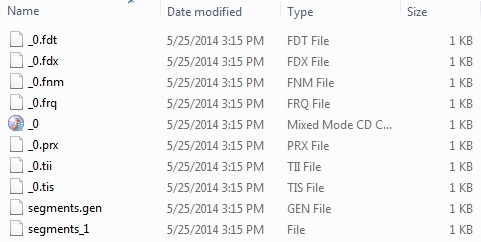Lucene Field選項
Field 是最重要的和索引進程的基礎單元。它是要索引包含的內容的實際物件。當我們新增一個欄位,Lucene提供使用Field 項欄位,其中規定欄位是要搜尋的許多控制。
我們新增包含欄位IndexWriter,IndexWriter用於更新或建立索引檔案。
現在,我們將展示一個循序漸進的過程,以獲得一個開始在使用基本的例子,在不同 Field 選項的理解。
各種Field選項
-
Index.ANALYZED - 先分析然後做索引。用於普通的文字索引。分析儀將打斷該欄位的值轉換成標記流,每個令牌是搜尋分開。
-
Index.NOT_ANALYZED - 不分析,但這樣做索引。用於完整的文字索引,例如人的名字,URL等。
-
Index.ANALYZED_NO_NORMS - 變式Index.ANALYZED。分析儀將打破該欄位的值轉換成標記流,每個令牌是搜尋分開,但規範是不儲存在indexes.NORMS被用來提高搜尋但有時記憶體消耗。
-
Index.Index.NOT_ANALYZED_NO_NORMS - 變式Index.NOT_ANALYZED。索引是這樣做,但規範NORMS是不儲存在索引。
-
Index.NO - 欄位值不搜尋。
使用Field選項
-
建立一個方法來從文字獲取Lucene的文件。
-
建立各種型別的是含有鍵作為名稱和值作為內容被編入索引鍵值對欄位。
-
設定欄位進行分析與否。在這裡,只有內容是要被分析,因為它可能包含資料,諸如,a, am, are, an等它不要求在搜尋操作等等。
-
新建立的欄位新增到文件物件並返回給呼叫者的方法。
private Document getDocument(File file) throws IOException{ Document document = new Document(); //index file contents Field contentField = new Field(LuceneConstants.CONTENTS, new FileReader(file)); //index file name Field fileNameField = new Field(LuceneConstants.FILE_NAME, file.getName(), Field.Store.YES,Field.Index.NOT_ANALYZED); //index file path Field filePathField = new Field(LuceneConstants.FILE_PATH, file.getCanonicalPath(), Field.Store.YES,Field.Index.NOT_ANALYZED); document.add(contentField); document.add(fileNameField); document.add(filePathField); return document; }
應用程式範例
讓我們建立一個測試Lucene的應用程式來測試索引處理。
| 步驟 | 描述 |
|---|---|
| 1 | 建立一個LuceneFirstApplication在包packagecom.yiibai.lucene下。也可以使用EJB建立的專案 |
| 2 | 建立LuceneConstants.java,TextFileFilter.java和Indexer.java。保持其它的檔案不變。 |
| 3 | 建立LuceneTester.java如下所述。 |
| 4 | 清理和構建應用程式,以確保業務邏輯按要求工作。 |
LuceneConstants.java
這個類是用來提供可應用於範例應用程式中使用的各種常數。
package com.yiibai.lucene; public class LuceneConstants { public static final String CONTENTS="contents"; public static final String FILE_NAME="filename"; public static final String FILE_PATH="filepath"; public static final int MAX_SEARCH = 10; }
TextFileFilter.java
此類用於 .txt檔案過濾器。
package com.yiibai.lucene; import java.io.File; import java.io.FileFilter; public class TextFileFilter implements FileFilter { @Override public boolean accept(File pathname) { return pathname.getName().toLowerCase().endsWith(".txt"); } }
Indexer.java
這個類是用於索引的原始資料,這樣我們就可以使用Lucene庫,使其可搜尋。
package com.yiibai.lucene; import java.io.File; import java.io.FileFilter; import java.io.FileReader; import java.io.IOException; import org.apache.lucene.analysis.standard.StandardAnalyzer; import org.apache.lucene.document.Document; import org.apache.lucene.document.Field; import org.apache.lucene.index.CorruptIndexException; import org.apache.lucene.index.IndexWriter; import org.apache.lucene.store.Directory; import org.apache.lucene.store.FSDirectory; import org.apache.lucene.util.Version; public class Indexer { private IndexWriter writer; public Indexer(String indexDirectoryPath) throws IOException{ //this directory will contain the indexes Directory indexDirectory = FSDirectory.open(new File(indexDirectoryPath)); //create the indexer writer = new IndexWriter(indexDirectory, new StandardAnalyzer(Version.LUCENE_36),true, IndexWriter.MaxFieldLength.UNLIMITED); } public void close() throws CorruptIndexException, IOException{ writer.close(); } private Document getDocument(File file) throws IOException{ Document document = new Document(); //index file contents Field contentField = new Field(LuceneConstants.CONTENTS, new FileReader(file)); //index file name Field fileNameField = new Field(LuceneConstants.FILE_NAME, file.getName(), Field.Store.YES,Field.Index.NOT_ANALYZED); //index file path Field filePathField = new Field(LuceneConstants.FILE_PATH, file.getCanonicalPath(), Field.Store.YES,Field.Index.NOT_ANALYZED); document.add(contentField); document.add(fileNameField); document.add(filePathField); return document; } private void indexFile(File file) throws IOException{ System.out.println("Indexing "+file.getCanonicalPath()); Document document = getDocument(file); writer.addDocument(document); } public int createIndex(String dataDirPath, FileFilter filter) throws IOException{ //get all files in the data directory File[] files = new File(dataDirPath).listFiles(); for (File file : files) { if(!file.isDirectory() && !file.isHidden() && file.exists() && file.canRead() && filter.accept(file) ){ indexFile(file); } } return writer.numDocs(); } }
LuceneTester.java
這個類是用來測試Lucene庫的索引能力。
package com.yiibai.lucene; import java.io.IOException; public class LuceneTester { String indexDir = "E:\Lucene\Index"; String dataDir = "E:\Lucene\Data"; Indexer indexer; public static void main(String[] args) { LuceneTester tester; try { tester = new LuceneTester(); tester.createIndex(); } catch (IOException e) { e.printStackTrace(); } } private void createIndex() throws IOException{ indexer = new Indexer(indexDir); int numIndexed; long startTime = System.currentTimeMillis(); numIndexed = indexer.createIndex(dataDir, new TextFileFilter()); long endTime = System.currentTimeMillis(); indexer.close(); System.out.println(numIndexed+" File indexed, time taken: " +(endTime-startTime)+" ms"); } }
資料和索引目錄的建立
使用10個檔案從 record1.txt 到 record10.txt 的文字檔案包含簡單的名稱以及學生的其他細節,並把它們放在目錄 E:LuceneData。這些資料用於測試。索引目錄路徑應建立為E:LuceneIndex。執行此程式後,就可以看到該檔案夾中建立的索引檔案的列表。
執行程式:
一旦建立源,創造了原始資料,資料目錄和索引目錄來完成,準備好這一步是編譯和執行程式。要做到這一點,在LuceneTester.Java檔案索引標籤中使用Eclipse IDE 的Run選項,或使用Ctrl+ F11來編譯和執行應用程式LuceneTester。如果應用程式一切正常,將在Eclipse IDE控制台列印以下訊息:
Indexing E:LuceneDataecord1.txt Indexing E:LuceneDataecord10.txt Indexing E:LuceneDataecord2.txt Indexing E:LuceneDataecord3.txt Indexing E:LuceneDataecord4.txt Indexing E:LuceneDataecord5.txt Indexing E:LuceneDataecord6.txt Indexing E:LuceneDataecord7.txt Indexing E:LuceneDataecord8.txt Indexing E:LuceneDataecord9.txt 10 File indexed, time taken: 109 ms
一旦成功地執行程式,將有以下的索引目錄中的內容:
